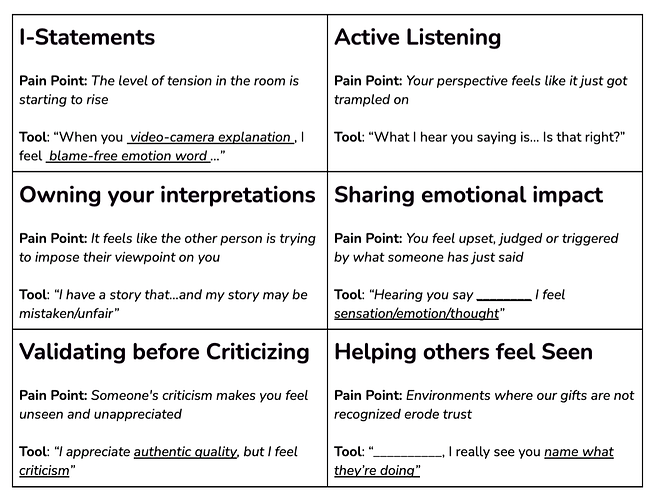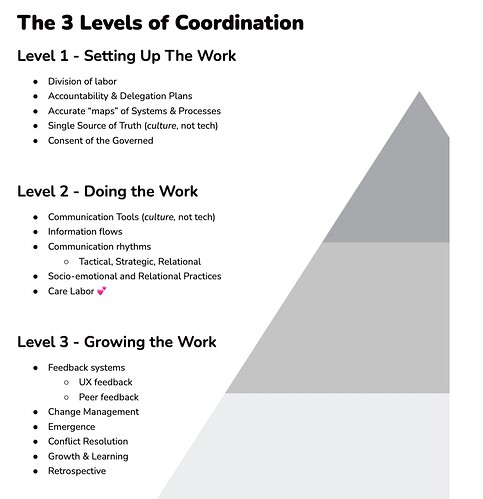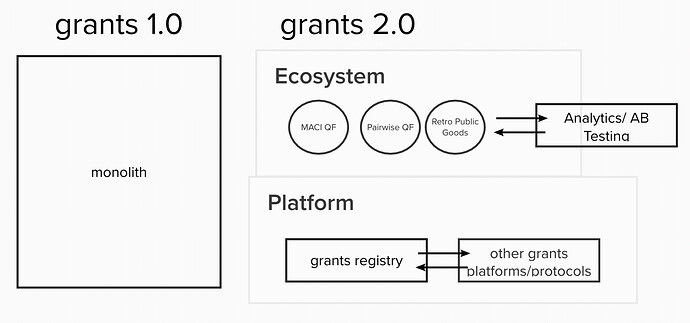Here is mine in no particular order:
3 dimensional humans
Being physically present with each other has taken us from zoom avatars to being physically 3 dimensionally present with each other. For me, this was profound in many ways - it was especially intense since the pandemic has meant its been a while since we’ve been truly physically present & communed in all of the ways that entails, with our coworkers.
For me, the primary takeaway of this is a deepened sense of the humanness of each of these coworkers. I tried to take a moment to appreciate each and every one of the ppl who are here (remote participants included).
Decentralization of human organizations is hard
As opposed to a geth client, which can hold all of the same state as other geth clients, each “node” in a DAO has different skills, ambitions, time constraints, communication styles, history, etc. Because of this, its just very hard (costly)? to decentralize (make antifragile) things we work on.
A great twitter thread on this: https://twitter.com/chaserchapman/status/1489663192213209088
Protocol Launches
If we play our cards right, our ProtocolDAO/ImpactDAO sandwich in 12-24 months could have launched (and be scaling) the following protocols/DAOS:
- dGrants
- dPOPP
- Coordination Kit
- KERNEL
- dCompass
- maybe 1 or 2 inchoate ideas that are not announced yet
and the DAO will have done interop agreements with several other DAOs.
One learning is that events like ETHDenver are “gravity wells” that suck product launches into them. There have been a handful of prominent launches that have happened at ETHDenver or similar events (most famously, MolochDAO launched at ETHDenver). We should consider announcing our launches at future events.
Partnerships
We had conversations about what it would look like to partner with other DAOs a handful of times. Aligning culture, technology, and incentives, are hard. But as the DAO to DAO ecosystem begins to develop and DAOs move from single cellular organisms to multi cellular organisms, I think it will be increasingly common.
Bottoms Up Leadership
Bottoms up leadership was in display in many many different ways in the event. I had fascinating conversations about insights across the DAOs portfolio with many people I encountered. One thing I’m mulling over is how to plan for this emergent aspect of things in everything we do.
One tangible observation: For ETHDenver, we just chose a meme of “Take the Green Pill”, made budget available for it, and several groups launched activations for it.
These are all of the activations that were launched one that schelling point had been created:
- Song a day man
- Emceeing / to sing a short song about every attendee
- Around the venue
- Robot Rasperberry Pis (Kyle/BestApe)
- Flyers(Ben)
- Green Pills in bowls around venue with stickers that say “Take the green pill” (Owocki)
- Actors performing solarpunk things (Jon)
- Swag
- Kevins book available (400 physical copies)
- Schelling Point / Green Pill Socks
- Stickers
- Hackey Sack
- POAPAthon: We are dropping 1,000+ pog packs at ethdenver and would be great to collaborate.
-
Green Pill Pins (BestApe)
- Pizza Lunch @ noon for 2k people (Thanks PizzaDAO)
- Art Gallery
- In person gallery, online auction to benefit Gitcoin
- Virtual hackathon
- Connected Events
- Performers- Jugglers, Multiple acts at staggered times
In the future, how we can create schelling points around launches like this? How can we deepen our ability to be a channel where greater combinations of strength and intelligence come together.
Finding the light in the darkness
We know from the Blue Ocean post that there are two ways to explore the design space we are in:
- a priori: reasoning or knowledge which proceeds from theoretical deduction rather than from observation or experience
- empirically: verifiable by observation or experience rather than theory or pure logic.
I found both types of thinking on display at this event, and it was extremely rich to combine them.
People Medicine
We did an excellent training with People Medicine. The primary lessons were on for group communication:
and on coordination:
Artificial Barriers
Im increasingly of the mind that the barriers between workstreams are artificial and we need to figure out how to do cross stream collaboration better.
Perhaps this means orienting work around outcomes as much as we do skillsets. Perhaps this means encouraging an matrix org to emerge.
One example is Gitcoin Product Group and Moonshot Collective. MC takes products from 0 to 1. GPG takes them from 1 to 10. A common social, technical, cultural, process substrate for these groups could perhaps serve us well.
More broadly speaking, I think that more coordination across workstream will serve us well. That might mean common social, technical, cultural, processes. That might mean rotating people around the DAO. That maybe means coming up with token allocation methodologies that span the entire DAO (instead of within a workstream)
Solving the Meta-Problem
One common strand through many conversations is “how do we solve the meta problem?” eg not just solving a problem, but solving for the problem behind the problem.
one tangible example: the thinking on grants has evolved. instead of having a grants protocol with QF in it, what if we instead create a protocol with a deep liquidity of grants on it, and create an ecosystem on top of it where different flavors of public goods funding can compete in order to optimally allocate capital on top of it.
the “problem” here is public goods funding
the “meta-problem” is finding the optimal capital allocation tool for public goods funding.



